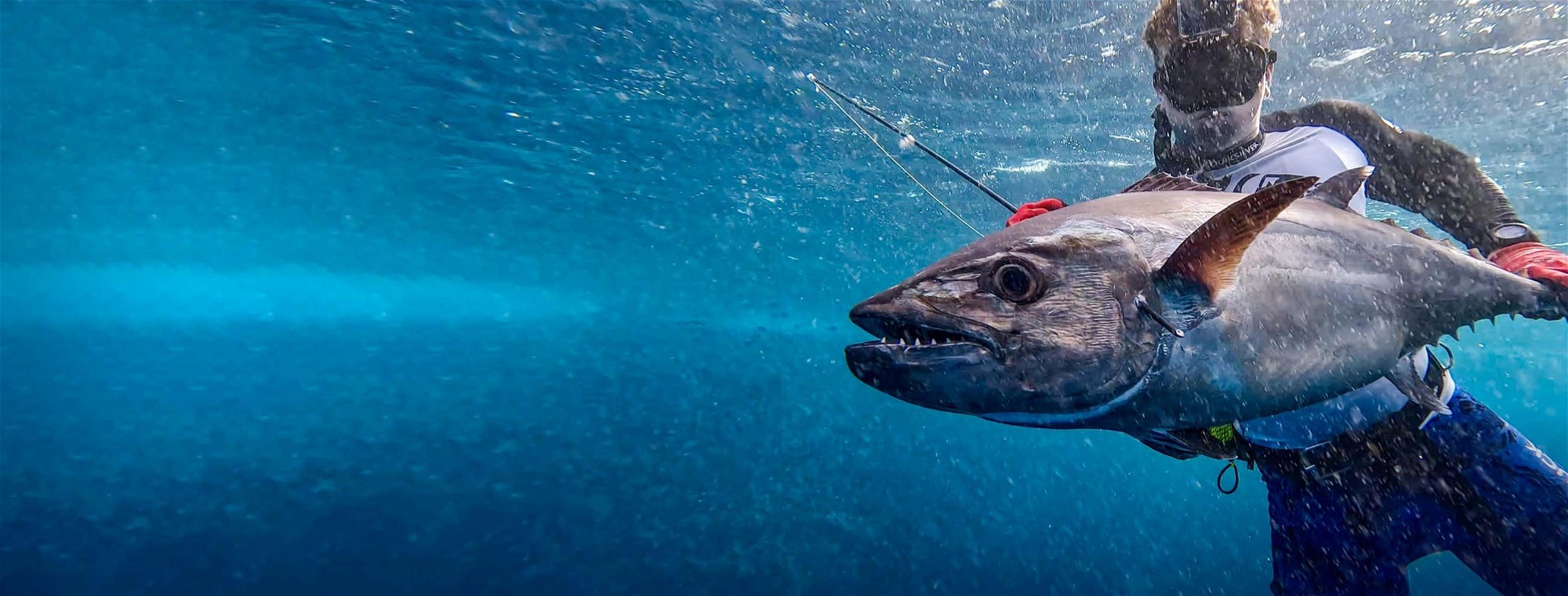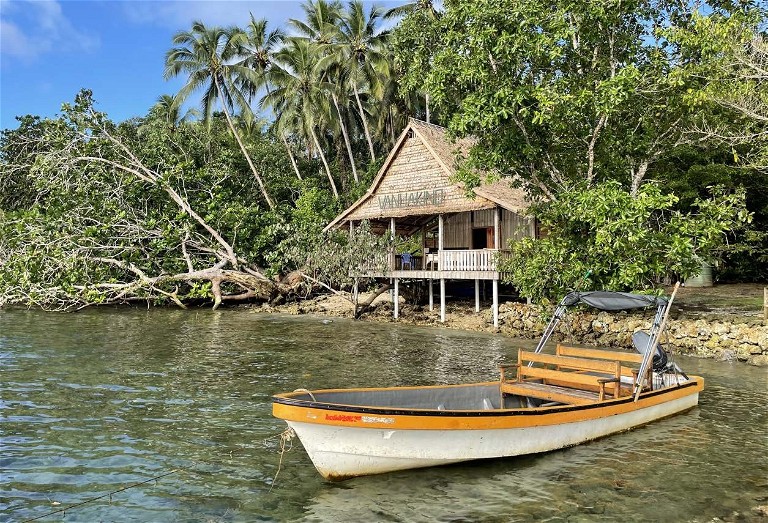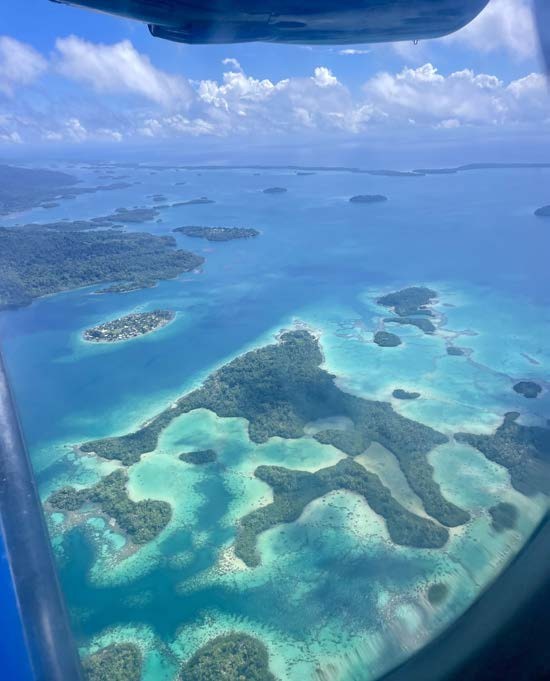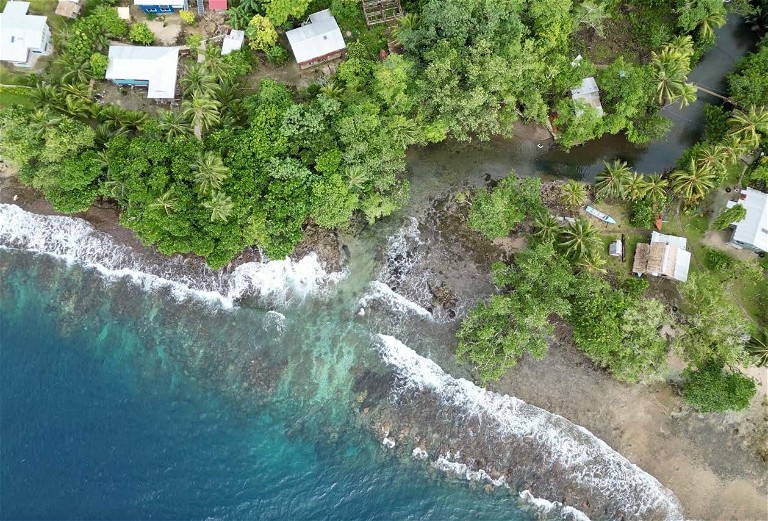GET THE DOGS
Spearing at the Solomon Islands
By Ollie Craig
When most Kiwis look for a holiday or dive trip in the Pacific Islands, the usual places such as Rarotonga, Fiji, Niue, Tonga, Samoa, Vanuatu, etc. pop into mind. All these places are incredible, yet after years of travelling around the world on an explorer motor yacht, I found that my favourite places to explore were definitely ‘off the beaten track’ – the harder to get to, the better.

I started scouting Google Maps to look for an option for my upcoming spearfishing trip, finding some incredible-looking locations. However, it is very difficult trying to organise a trip to some of these places as there is bugger all information on the internet. Is it safe? Is the diving good? Is there any accommodation? How do I even get there?!
Sometimes, trips like these require a bold move – just book flights and go with the flow. Most island nations are home to friendly people, who will take you into their homes and help to organise dive trips out with local fishermen.
As I was scanning online, I came across the Solomon Islands – not a very commonly promoted destination (from New Zealand anyway), but the topography and location looked fantastic for what I wanted to achieve. I managed to find a lodge marked on Google Maps in a remote location and investigated further.
“Wow! I’ve landed on a goldmine,” I thought to myself as I discovered it was a lodge set up for spearfishing, with access to deep water nearby, with fish attracting devices (FADs) and reports showing plenty of fish life with warm, crystal-clear water. Sold! I enquired about some dates but found they didn’t survive through the COVID-19 years.
However, I was passed on to an up-and-coming eco-lodge run by some Australians.
I got in touch with Matt from the lodge, and after a good chat on the phone I discovered he was also an avid freediver and spearo. I was beyond excited to check the place out. The only problem, though, was I also wanted to catch up with a friend in Fiji for some spearfishing and had booked two weeks there already. Stuff it, you only live once, I figured, and booked two weeks in the Solomons to add to my Fiji trip!
It was only a short three-hour flight from Fiji to Honiara – the Solomon Islands’ capital. After an overnight layover, and then another hour-long flight on a small plane, I was nearly at my destination, with signs of isolation including a grass runway and no more roads anywhere in sight. I had made it to the Marovo Lagoon, the largest saltwater lagoon in the world.
A short longboat ride later, I was at my accommodation for the night – a beautiful little thatched roof bungalow with a big balcony jutting out into the picturesque lagoon. Very eager to get in the water, I spoke with the owner who advised me not to swim in front of the bungalow as there were too many saltwater crocs around (he had killed three crocs nearby in as many weeks). He said it was safe on the other side near the airport where supposedly there was a WW2 bomber plane wreck. Great! A wreck dive and a chance to get a fish for lunch or dinner. I took his word regarding the crocs.
I paddled over in an old kayak and entered the green water which was a bit unnerving. It was, however, a ‘clear green’ which other divers will understand. I soon found the bomber plane, a Lockheed YP-38 twin-engine fighter, and explored the wreck. I managed to spear a nice mangrove jack which the owners of the bungalows cooked up for me beautifully with fresh ginger, lime and curry powder.

The next day I was picked up in another longboat by the crew at the lodge and we made our way around the giant lagoon towards my final destination. It was a last-minute call to pick me up that afternoon, and as I took in the stunning sunset and views along the way I was well aware that we were soon to be travelling in darkness. I was warned by our captain Greg that we were soon to be exiting the inner lagoon and heading into some rough weather.

He wasn’t lying. We were shortly bouncing around, negotiating the swell and chop, and getting sprayed with water. It was pitch black, I was soaked and I was stuck in a longboat in the middle of nowhere with no sounder or GPS. Nevertheless, I felt calm as no doubt Greg had lived there his entire life and could probably do the trip blindfolded (which wasn’t far off with the current view)!
As we approached land and a bunch of dotted lights, I heard lots of shouting and I could briefly make out the shore and crashing waves in the little moonlight on offer. I braced myself for a beach landing as we hurtled towards the shore, riding the big swell while getting pelted with rain. Suddenly, along with some big cheers from a bunch of locals, we burst through into a calm estuary and pulled up to a little wooden dock. We had made it.
We made our way up a winding track through the forest for a few minutes to the lodge. Dripping wet and looking like a possum in the headlights, I enter and met Gabriel, one of the lodge owners, along with Stu and Sharon, a couple from Papamoa. I wasn’t the only adventurous Kiwi there.

Nestled in the dense forest growing atop ancient coral was the lodge, all made from locally sourced hardwood timbers with a view out to the amazing Marovo Lagoon dotted with coconut trees. The place was incredible – relaxing and comfortable, with good vibes, no roads or shops, and only a couple of villages lining the bay. I needed a mental reset, and this place was the cure.

Matt (the lodge founder), along with business partner Jordie, arrived the next day which meant time for spearfishing. For the remainder of my trip, each day consisted of a beautiful breakfast cooked up with fresh, local, organic ingredients (funny how we have to state ‘organic’ these days, along with terms such as ‘grass-fed beef’, when really these are just normal), followed by some reading, stretching, freedive training right in front of the lodge where the reef drops straight off to hundreds of metres, another beautiful lunch cooked up by the lovely women in the kitchen, a stroll through the villages or into the forest, and a little afternoon nap before my favourite part of the day – each afternoon we would gear up and head out on the longboat to one of the local dive spots to hunt the day’s catch!


Being relatively new to tropical diving, there were plenty of species I was eager to tick off my list so I was pumped to get stuck into the action. The lodge owners, along with the local spearfishing guides, were all very experienced divers, which provided peace of mind as I knew that I was going to be diving deep and pushing my limits if I was to land some of these fish. Day after day we would head out in the afternoon as it was the best time to be diving – the sun would start to set and the reefs would come to life with fish actively feeding, including the desirable predatory pelagics such as dogtooth tuna.
Typically, I dive down to around 15 to 18 metres when spearing in New Zealand. However, after my trip to Fiji and a few days into my Solomons trip, I was starting to hit some good depths with the help of warm, clean water, and tips and tricks from the guys. The 20- to 30-metre depths were soon becoming easy enough and later in my trip I made it down to 31.8 metres – by far my PB!
I was managing the odd fish each day and it didn’t matter too much what I got; I was just happy being in this beautiful part of the world and spending time with some special people. However, deep down I had my heart set on spearing my first dogtooth tuna, and luckily I was in the right place at the right time, with doggie season just kicking into gear.


The stars aligned a few days into my trip. About half an hour into our afternoon dive session at a local reef nicknamed ‘Five O’clock Doggie’ I performed my breathe-up on the surface, relaxing every muscle in my body, relaxing my mind, and lowering my heart rate before that one final gulp of oxygen. I duck-dived and kicked down to 15 metres where I hit freefall, sinking further down to find a nice position on the steep reef wall where I would come to rest and lie patiently at 22 metres.
The trick here was to lie very still, hide your face, and ignore the sharks while looking down at the reef until the baitfish came in to inspect you. Then, you would have to wait further until large fish such as spanish mackerel, giant trevally and tuna hopefully came in for a look, all while holding your breath (in my case up to just over two minutes).
Once in position, a nice coral trout appeared. I slowly started to stretch out my speargun, then I caught a glimpse of movement from the corner of my eye – a big school of dogtooth buzzing past! I only had a few seconds to act and luckily they swam right in front of me, enabling me to lift and extend my speargun just in time to take a shot. I hit the biggest fish in the school perfectly, sending the spear right through the brain, stopping it in its tracks!
My heart was pounding, using up more of my precious oxygen reserves as I made my way to the surface kicking hard and dragging up the beast. I was met on the surface with cheers from the guys and celebrations back at the lodge. With a few cold beers and a lovely fresh meal, it was smiles all ‘round.
Many other fish were speared on the trip including a nice spanish mackerel, midnight snapper, GT, coral trout, and, unexpectedly, another big dogtooth tuna which landed me the nickname ‘Doggie Boy’ from the locals. I also saw turtles, lots of sharks, numerous reef species, exquisite coral gardens with swim-throughs, incredible amounts of fish life, dolphins – you name it, I saw it, except for saltwater crocs!
With bad weather most of the trip we were limited to only a few inshore dive spots. Given the success found only a few minutes by boat from the lodge, I can’t wait to get back and explore some more of the area, including one spot where you can dive right next to an active underwater volcano (which I could often hear rumbling while diving, even though it was over 50km away!).
The lodge is amazing, and plenty of other activities are available like hunting coconut crabs in the bush or heading out gamefishing for mahimahi, tuna, sailfish and marlin. Stu from Papamoa landed a huge yellowfin tuna along with mahimahi while we were there.
There is much more in the Pacific Islands than the usual destinations. The Solomons are safe, full of friendly people, unbelievably beautiful and very untouched in places. Step out of your comfort zone and explore a little more, you won’t regret it.